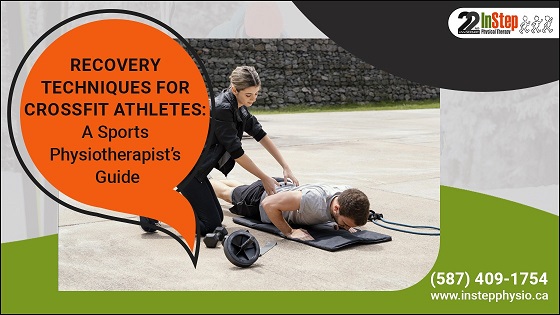CrossFit is one of the most challenging and rewarding training regimens for athletes, combining high-intensity functional movements with strength training. However, the physical demands of CrossFit can lead to muscle fatigue, joint stress, and an increased risk of injury if proper recovery isn’t prioritized. Recovery is a crucial part of maintaining performance and avoiding setbacks. Sports physiotherapy in Edmonton offers targeted strategies to help CrossFit athletes recover effectively, reduce the risk of injuries, and improve long-term performance.
Why Recovery Matters for CrossFit Athletes
The intensity of CrossFit workouts can place significant strain on the body. Without proper recovery, athletes may experience:
- Muscle Fatigue: Overworked muscles can lead to soreness and reduced strength.
- Joint Stress: Repetitive movements may cause inflammation or joint pain.
- Increased Injury Risk: Neglecting recovery increases the likelihood of strains, sprains, or overuse injuries.
- Performance Plateaus: Inadequate recovery prevents muscles from rebuilding, limiting gains in strength and endurance.
Essential Recovery Tips for CrossFit Athletes:
Sports physiotherapy in Edmonton offers essential recovery techniques that every CrossFit athlete should incorporate into their training regimen.
Prioritize Active Recovery
Active recovery involves low-intensity exercises that promote blood flow, reduce soreness, and speed up muscle repair. Unlike complete rest, active recovery keeps the body moving in a gentle, controlled way.
Examples of Active Recovery:
- Light jogging or cycling for 15–20 minutes
- Swimming, which reduces strain while engaging multiple muscle groups
Active recovery sessions are ideal after particularly intense CrossFit workouts, as they minimize stiffness while helping the muscles recover faster. Incorporating these into your weekly routine ensures better results without overtaxing the body.
Use Mobility Exercises to Prevent Stiffness
Mobility is a cornerstone of CrossFit performance. Tight muscles or restricted joints can limit movement, maximize the risk of injury, and compromise performance during complex lifts or high-rep exercises.
Mobility Exercises to Include:
- Foam Rolling: Utilize a foam roller to ease tension in major muscle groups, including quads, hamstrings, and shoulders.
- Dynamic Stretches: Incorporate movements like arm circles, hip openers, and spinal twists to prepare your body for future workouts.
- Resistance Band Work: Target specific joints or muscle groups to improve flexibility and mobility.
Sports physiotherapists often recommend mobility exercises as part of a comprehensive recovery plan for athletes, especially those involved in high-impact training like CrossFit.
Focus on Nutrition and Hydration
Recovery doesn’t just happen in the gym—it starts in the kitchen. Ensuring proper hydration and diet promotes healthy muscle recovery and reduces inflammation.
What to Focus On:
- Protein: Consume high-quality protein to rebuild muscle fibres damaged during intense workouts.
- Carbohydrates: Replenish glycogen stores with healthy carbs like fruits, oats, or sweet potatoes.
- Anti-Inflammatory Foods: Add omega-3-rich foods like salmon, nuts, and avocados to reduce inflammation.
Staying hydrated is equally important, as dehydration can delay muscle recovery and exacerbate fatigue. Drinking water and electrolyte-rich beverages throughout the day supports optimal recovery.
Incorporate Rest and Sleep
While active recovery is beneficial, complete rest is also necessary for muscle repair and overall recovery. Sleep is particularly crucial, as it is during this time that the body undergoes its most significant healing and repair processes.
Rest Guidelines for CrossFit Athletes:
- Take at least one or two full rest days per week, depending on your workout intensity.
- Aim for 7–9 hours of sleep each night to promote recovery and reduce fatigue.
- Use relaxation techniques like deep breathing to improve sleep quality.
Sports physiotherapists emphasize the importance of balancing rest and activity, especially for athletes engaged in demanding training regimens.
Seek Sports Physiotherapy for Targeted Recovery
For CrossFit athletes dealing with persistent soreness, injuries, or mobility challenges, sports physiotherapy can provide tailored recovery strategies. Sports physiotherapists assess movement patterns, identify imbalances, and address injuries through specialized techniques.
Manual Therapy
Manual therapy involves hands-on techniques designed to release muscle tension, enhance joint mobility, and reduce pain. For CrossFit athletes, these methods target areas of overuse and strain caused by high-intensity workouts.
- Soft Tissue Mobilization: Focuses on loosening tight muscles, breaking down scar tissue, and improving circulation.
- Joint Mobilizations: Targets restricted joints, such as shoulders and knees, to restore range of motion.
- Trigger Point Therapy: Releases knots or tight bands in muscles, commonly found in the traps, lats, or quads in CrossFit athletes.
Injury Rehabilitation
Injury rehabilitation focuses on restoring function, strength, and mobility after an injury. CrossFit athletes often experience strains, sprains, and overuse injuries due to the physical strain of their training.
- Eccentric Strengthening Exercises: Gradual muscle-lengthening exercises, such as eccentric calf raises for Achilles tendon injuries or Nordic hamstring curls for hamstring strains.
- Progressive Loading: Gradual reintroduction of weights, such as deadlifts or kettlebell swings, to rebuild strength safely while avoiding re-injury.
Modalities for Pain Relief and Recovery
Modalities are physical agents or tools used to enhance the healing process and provide discomfort relief. Sports injury physiotherapy offers techniques to speed up recovery and reduce discomfort for CrossFit athletes.
- Ultrasound Therapy: Utilizes sound waves to promote tissue healing and minimize inflammation in injured areas such as tendons or ligaments.
- Electrical Stimulation (TENS): Relieves pain by stimulating nerves and improving muscle function, particularly in the back, shoulders, or quads.
- Cupping Therapy: Enhances circulation and reduces muscle tension by creating suction in specific areas, which is popular among CrossFit athletes for recovery.
Prioritize Recovery for Long-Term Success
Recovery is just as important for CrossFit athletes as the workouts themselves. Neglecting recovery not only increases the risk of injury but also limits athletic progress. Sports physiotherapy in Edmonton provides valuable tools and guidance to enhance recovery, prevent injuries, and improve performance. If you’re searching for professional care, In Step Physical Therapy in Edmonton offers tailored treatments to meet the demands of CrossFit athletes. By prioritizing recovery, athletes can train harder, stay injury-free, and achieve their fitness goals with confidence.

